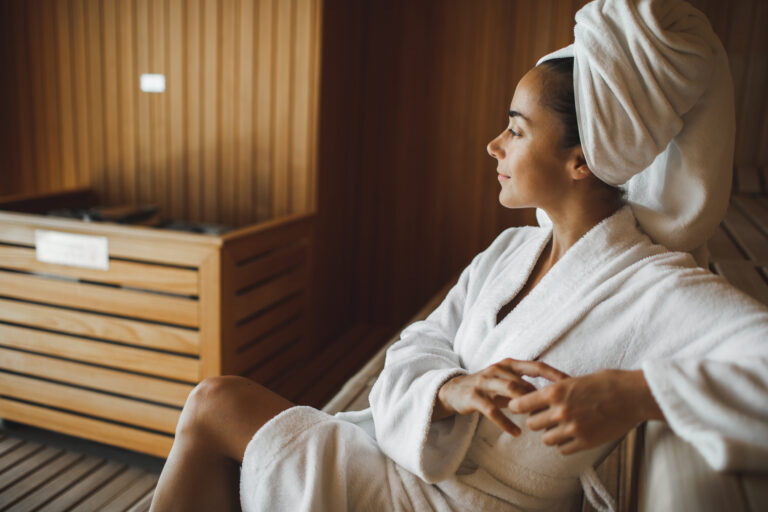What is wellness tourism?
Wellness tourism is travel with an aim to maintain or improve health, wellbeing and quality of life. Wellness tourism examples include spa retreats, yoga holidays, fitness getaways and nature-focused escapes, which typically blend relaxation with healthy living practices.
Wellness tourism is one of the global travel industry’s fastest-growing segments. Rising interest in self-care, stress relief and healthy living has seen a wealth of hotels and travel service providers craft offerings that speak to a more health-conscious customer base.
Where traditional leisure travel places a focus on simple relaxation, health and wellness tourism focuses on proactive wellbeing. Wellness travellers seek out spa treatments, guided meditation, yoga classes, fitness camps, or immersive experiences in nature. The sector also extends to medical wellness, where hotels and other providers offer treatments for specific health issues.
For small, independent hotels, wellness tourism represents an incredible opportunity. By diversifying your services, you can attract health-conscious travellers that are often willing to pay more than other guests. You can also tap into year-round demand, as wellness trips are less tied to peak holiday seasons.
Earn more by crafting truly satisfying guest experiences
Streamlined booking and check-in, enhanced communication, more revenue through direct bookings; with help from Little Hotelier, you can make the most of the opportunity presented by wellness tourism.
Explore our property management systemWhy is the wellness tourism market important?
The wellness tourism market is important because it represents a rapidly growing segment of global travel, attracting travellers willing to spend more on experiences that enhance health and wellbeing. It drives economic growth for destinations, supports niche hospitality offerings, and encourages year-round tourism.
In 2023, 7.8% of all tourist trips were wellness-based, but these trips accounted for 17.9% of all tourism expenditures. This indicates that wellness travellers spend more than double the average traveller per trip. Globally, the wellness tourism market is valued at almost US$1 trillion, and continues to grow faster than general tourism.
By investing in wellness-focused experiences, a small, independent hotel can differentiate itself and attract this valuable cohort. Wellness tourism also tends to have a focus on longer stays, and isn’t as bound to peak seasons as general travel, minimising the financial volatility that most hotels are forced to contend with.
Wellness tourism also places a particular focus on add-on services that can significantly increase the average revenue generated per guest: on-site massages, yoga classes and spa treatments are high-margin and can also be quite simple to set up.
Key takeaways
- Wellness travellers spend more than double the average tourist.
- The sector is worth nearly US$1 trillion globally and growing faster than general tourism.
- Wellness offerings encourage longer stays, reduce seasonal volatility, and encourage high-margin purchases.
What are wellness tourism examples for hotels?
Wellness tourism examples for hotels include spa retreats, yoga/meditation programs, fitness-focused stays, and nature-based experiences designed to improve physical and mental wellbeing. Hotels may also offer healthy dining options, wellness workshops and personalised wellness packages.
If you run a small, independent hotel, and you’re looking for health and wellness tourism examples as inspiration for your own efforts, you should first consider the health and wellness offerings that align with the type of guest you tend to attract, your brand personality, and your property, amenities and local area. Options include:
- Mind-body fitness programs: Offer sunrise beach yoga sessions a few times a week, weekend pilates workshops with visiting instructors, or evening tai chi and qigong classes in your courtyard or garden.
- Mindfulness retreats: Create peaceful spaces for guided meditation or self-reflection sessions, or host weekend digital detox retreats with journalling, breathwork and structured periods of silence.
- Fitness-focused stays: Include timetables for group fitness classes and offer optional one-on-one personal training sessions. Sell packages that feature daily workouts, fitness assessments and tailored recovery programs.
- Physical therapies: Develop a day spa menu combining massages, facials and aromatherapy, alongside more targeted treatments that address specific issues like recovery, tension, jet lag or fatigue.
- Nutrition experiences: Introduce seasonal menus rich in local, organic produce and with plant-based options. Run interactive cooking classes or nutrition talks with visiting chefs or dietitians.
- Nature-based experiences: Design guided outdoor activities tailored to your setting – hikes, surf lessons, cycling tours – with equipment hire and post-activity recovery amenities.
- Sleep/recovery-focused stays: Offer pillow menus, blackout curtains, sound therapy, aromatherapy and relaxation workshops to help guests unwind and improve the quality of their sleep.
- Holistic lifestyle or wellness immersion programs: Combine all the above – mindfulness, fitness, luxury, nutrition, nature, relaxation – into multi-day or multi-week packages that encourage total, long-term health and wellness.
If you consider health and wellness to be an ancillary service provided by your hotel, you can offer a selection of individual services that a guest can choose from. If you want to make health and wellness part of your hotel’s identity, you can create a complete program full of wellness activities that might run over the course of a week or more.
Key takeaways
- Hotels can offer wellness experiences like spa treatments, yoga, fitness, and nature-based activities.
- Wellness offerings should align with guest type, brand personality, property, amenities, and location.
- Health and wellness can be provided as individual services or a full immersive program.
How can small hotels promote wellness tourism packages to their guests?
The demand for health and wellness travel is strong, and only getting stronger:
- After the COVID‑19 downturn, wellness trips grew by 30.2% annually from 2020 to 2022, and wellness tourism expenditures by 36.2% annually over the same period.
- In the Asia Pacific region, 55% of surveyed travellers say they want local wellness experiences as part of their accommodation.
- The desire is even greater within the luxury travel segment, with more than 90% of luxury travellers now expecting wellness services tailored to their health goals.
The challenge for an independent hotel is to capitalise on this ever-growing demand. Here’s how a small hotel can effectively craft and promote health and wellness offerings.
1. Create wellness tourism packages
Bundle your wellness services into cohesive packages designed for the health-conscious travellers your property attracts. A weekend wellness package, for example, might include yoga sessions every morning and evening, regular spa treatments, and healthy dining options for breakfast, lunch and dinner.
Wellness packages can vary in length, intensity and focus. Some might be short “recharge” breaks, while others might be immersive retreats that last a week or more, and combine fitness, nutrition, mindfulness and nature. Consider offering a variety of options to appeal to both casual travellers and serious wellness seekers.
2. Promote wellness offerings
To effectively promote your wellness packages, you need to craft clear, visually appealing messaging, then display it across your site and socials, and in emails and paid advertising. Highlight what guests will get from your offerings: renewed health and wellness, a sense of community, unique and memorable experiences. Capture high-quality photos and videos of guests enjoying your health and wellness offerings, as this is powerful social proof that can encourage others to join.
Consider collaborating with local tourism boards and social media influencers to spread your message far and wide. An influencer with a small yet highly relevant and engaged audience can do more for your business than a big spend on traditional broadcast media like TV and radio, where you don’t have much control over who your marketing is delivered to.
3. Offer personalisation
Your guests are looking for a health and wellness retreat that speaks specifically to them, so personalisation is key. Simple customisations, like preferred spa treatments or meal choices, can significantly improve satisfaction. Let your guests choose from a range of activities and dining options, to create packages that are tailored to their interests, health goals and fitness levels.
Consider sending out a pre-arrival wellness survey to better understand each guest’s health and wellness goals. You can then make more relevant and targeted recommendations and suggest potential add-ons that can enhance the guest’s stay while helping you to make more money.
4. Collaborate with local wellness providers
By partnering with local wellness providers, such as yoga instructors, fitness trainers, nutritionists or spa therapists, you can expand your offerings without the need to make heavy investments in facilities and staff training. This instant injection of expertise can also seriously enhance the health and wellness experience you offer to guests.
Local partnerships can also provide cross-promotion opportunities. A local yoga studio or day spa could start referring its clients to your hotel, and you can do the same for them. These alliances strengthen your hotel’s connection to the local community and help complementary businesses share in your success.
5. Incentivise longer stays
Encouraging longer stays allows guests to fully engage with wellness programs, leads to higher revenue per booking, and helps to smooth out the seasonal volatility that is so common in the tourism industry.
Offer multi-day packages or tiered pricing that rewards guests who extend their stay, such as discounts on additional nights or complimentary wellness activities for bookings beyond a certain length. Establish week-long or month-long programs that have a clear objective for participants to work towards.
Longer stays also allow for more immersive experiences, such as multi-day yoga retreats or extended fitness programs designed to transform the body and mind. This approach not only increases profitability, but also fosters loyalty, as your guests become deeply familiar with your hotel and the other program participants, which can help to encourage future visits.
Maximise your bookings with smarter pricing
Get daily pricing recommendations based on real-time market data, so you can spend less time on rates and more time on guests.
Learn about Dynamic Revenue PlusKey takeaways
- Create tailored wellness packages that bundle services (spa, yoga, dining) into cohesive multi-day experiences designed for specific traveller types.
- Use pre-arrival surveys to personalise offerings and partner with local wellness providers to expand services without major facility investments.
- Incentivise longer stays through tiered pricing and multi-day packages to increase revenue per booking and smooth seasonal demand volatility.
What are some upcoming wellness tourism trends?
In 2025, wellness tourism is trending towards personalised experiences, tech integration, and a stronger connection to nature. Travellers are seeking customised wellness programs, digital detoxes, and destinations that support both physical and mental rejuvenation.
One key trend is personalised wellness journeys, where a hotel offers tailored packages designed to address specific health goals: reducing stress and anxiety, improving sleep, losing weight or achieving peak athletic performance. In these highly customised programs, guests enjoy bespoke itineraries, private consultations and treatments designed to meet their individual needs.
Another trend is the integration of advanced technologies, most notably fitness wearables and AI coaching. Smart watches can track everything from exercise intensity to sleep cycles, and this data can then be fed through AI-powered tools to analyse how a guest’s health and wellness can be improved.
Finally, nature-based destinations are growing in popularity. In some ways this is the flipside of the tech trend, where guests are pushing back against screens and prioritising immersive outdoor experiences. Hiking, swimming, climbing and outdoor yoga are pursuits that are as much about the mind as they are about the body. Combine this nature with a policy that limits phone use, and you can provide the escape from the modern world that is sought by an ever-increasing number of guests.
FAQs on wellness tourism
What is another name for wellness tourism?
Wellness tourism is also referred to as health and wellbeing travel or holistic travel. These names all refer to experiences designed to improve physical, mental and emotional health while on holiday.
Why is wellness tourism becoming more popular?
Wellness tourism is growing as more travellers focus on self-care and mental and physical health. Vacations are increasingly seen as an opportunity to reset the body and mind – a trend that is powering the popularity of wellness-focused accommodation providers.
What are the effects of wellness tourism?
Wellness tourism can represent a significant boost to a local economy, as health and wellness tourists tend to stay longer and spend more. The fact that they are on a journey of self-improvement means that they can also be more relaxed and respectful than guests who are there to party.
By Juhlian Pimping
Juhlian is the SEO and Content Manager at Little Hotelier, the all-in-one hospitality software designed specifically for small accommodation providers like boutique hotels, B&Bs, guesthouses, and inns. With extensive experience creating impactful content in the SaaS space since 2018, he specializes in developing resources that help property owners take back control of their daily operations, boost direct bookings, and enhance guest experiences.
Table of contents
“Booking is simple and quick, from a phone while outside. It helped me optimize my hotel for searches. I haven't needed online booking sites (or pay their fees).”
Owner, Quincy Hotel






